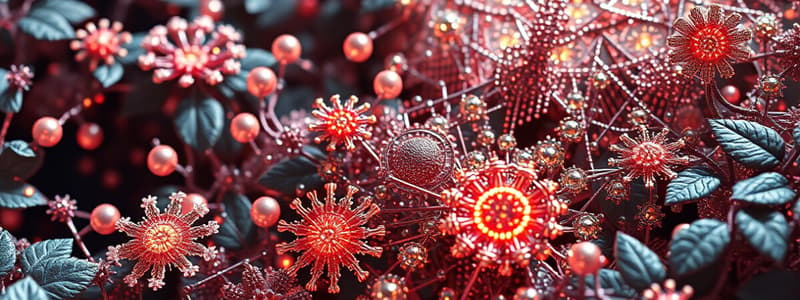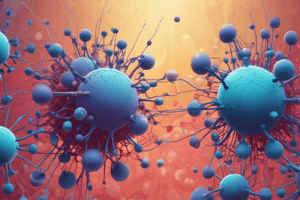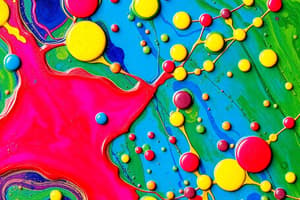Podcast
Questions and Answers
What is the typical size range for structures measured in nanotechnology?
What is the typical size range for structures measured in nanotechnology?
- 1–10 nanometers
- 1–100 micrometers
- 1–10 micrometers
- 1–100 nanometers (correct)
Which of the following is a property of nanocarriers that supports drug delivery?
Which of the following is a property of nanocarriers that supports drug delivery?
- Eliminating the need for targeting
- Reducing drug interaction with cell membranes
- Increasing drug solubility (correct)
- Decreasing drug bioavailability
What was the significance of the FDA's approval of nanomedicine clinical trials in 2015?
What was the significance of the FDA's approval of nanomedicine clinical trials in 2015?
- It marked the first use of nanocarriers for all diseases.
- It restricted the use of polymer devices in drug delivery.
- It indicated the inefficacy of nanoparticles in drug delivery.
- It allowed for the study of nanocarriers in cancer treatments. (correct)
What historical milestone in nanotechnology occurred in 1965?
What historical milestone in nanotechnology occurred in 1965?
What does the blood-brain barrier (BBB) primarily regulate?
What does the blood-brain barrier (BBB) primarily regulate?
Which of the following diseases can nanoparticles help target?
Which of the following diseases can nanoparticles help target?
In what year was the first controlled formulation approved by the FDA?
In what year was the first controlled formulation approved by the FDA?
What is one of the main roles of nanocarriers in drug delivery systems?
What is one of the main roles of nanocarriers in drug delivery systems?
Which of the following molecules can readily diffuse across the blood-brain barrier?
Which of the following molecules can readily diffuse across the blood-brain barrier?
What is the main advantage of using nanoparticles (NPs) for drug delivery across the blood-brain barrier?
What is the main advantage of using nanoparticles (NPs) for drug delivery across the blood-brain barrier?
Which transporter type is primarily responsible for glucose uptake in the brain's endothelium?
Which transporter type is primarily responsible for glucose uptake in the brain's endothelium?
Why do malignant brain tumors like glioblastoma have a poor prognosis?
Why do malignant brain tumors like glioblastoma have a poor prognosis?
What properties of nanoparticles enhance their ability to cross the blood-brain barrier?
What properties of nanoparticles enhance their ability to cross the blood-brain barrier?
What is the survival rate for glioblastoma patients after five years?
What is the survival rate for glioblastoma patients after five years?
Which characteristic of nanoparticles can improve circulation time and BBB binding?
Which characteristic of nanoparticles can improve circulation time and BBB binding?
What is the primary challenge in treating neurological diseases related to drug delivery?
What is the primary challenge in treating neurological diseases related to drug delivery?
What is a significant benefit of using transferrin in NP design for drug delivery to the brain?
What is a significant benefit of using transferrin in NP design for drug delivery to the brain?
How much faster are glucose-coated gold NPs transferred in cerebral endothelial cells compared to non-brain endothelial cells?
How much faster are glucose-coated gold NPs transferred in cerebral endothelial cells compared to non-brain endothelial cells?
Which peptide is mentioned as targeting the αvβ3-integrin receptor in brain disorders?
Which peptide is mentioned as targeting the αvβ3-integrin receptor in brain disorders?
What is the effect of insulin-coated gold NPs (INS-GNPs) in the brain, as compared to control GNPs?
What is the effect of insulin-coated gold NPs (INS-GNPs) in the brain, as compared to control GNPs?
What leads to the breakdown of the blood-brain barrier under pathological conditions?
What leads to the breakdown of the blood-brain barrier under pathological conditions?
Why are gold NPs with transferrin conjugation important for brain delivery?
Why are gold NPs with transferrin conjugation important for brain delivery?
Which of the following conditions is NOT associated with blood-brain barrier disruption?
Which of the following conditions is NOT associated with blood-brain barrier disruption?
What role does PEGylated albumin play in NP design for drug delivery to the brain?
What role does PEGylated albumin play in NP design for drug delivery to the brain?
What is the primary purpose of a drug delivery system designed to penetrate the blood-brain barrier (BBB)?
What is the primary purpose of a drug delivery system designed to penetrate the blood-brain barrier (BBB)?
Which of the following is NOT a type of nanoparticle mentioned?
Which of the following is NOT a type of nanoparticle mentioned?
What advantage do polymeric nanoparticles offer over other nanocarriers?
What advantage do polymeric nanoparticles offer over other nanocarriers?
Which method can help increase drug absorption in the brain via the nose-to-brain pathway?
Which method can help increase drug absorption in the brain via the nose-to-brain pathway?
What were the first polymers used to develop polymeric nanoparticles?
What were the first polymers used to develop polymeric nanoparticles?
What is the goal of using imaging/diagnostics under diseased conditions in drug delivery?
What is the goal of using imaging/diagnostics under diseased conditions in drug delivery?
In the context of drug delivery systems, what role do viral vectors play?
In the context of drug delivery systems, what role do viral vectors play?
What is the significance of using nanoshells in drug delivery?
What is the significance of using nanoshells in drug delivery?
What is a key advantage of polymer nanoparticles as drug carriers?
What is a key advantage of polymer nanoparticles as drug carriers?
Which of the following is a synthetic biodegradable polymer?
Which of the following is a synthetic biodegradable polymer?
What characterizes nanocapsules compared to nanospheres?
What characterizes nanocapsules compared to nanospheres?
Which property makes biodegradable polymeric nanoparticles suitable for drug delivery?
Which property makes biodegradable polymeric nanoparticles suitable for drug delivery?
Which of the following polymers is considered non-synthetic?
Which of the following polymers is considered non-synthetic?
What role does poly(ethylene glycol) (PEG) play in drug delivery systems?
What role does poly(ethylene glycol) (PEG) play in drug delivery systems?
What type of reactions were observed with nanosystems made from certain materials?
What type of reactions were observed with nanosystems made from certain materials?
Which of the following is a function of nanoparticle systems in drug delivery?
Which of the following is a function of nanoparticle systems in drug delivery?
Flashcards are hidden until you start studying
Study Notes
Nanotechnology
- The branch of science dealing with structures on the nanoscale, measuring 1-100 nanometers
- Includes disciplines like Physics, Chemistry, Biology, Engineering, Information Technology, Electronics, and Material Science
- Nanoparticles possess distinct material properties due to their submicroscopic size
- Widely used in various fields, including engineering, drug delivery, nanomedicine, environmental identification, and catalysis
- Effectively targets diseases like melanoma, cardiovascular disease, skin diseases, and liver diseases
History of Nanotechnology
- Polymers and drug conjugation was first reported in 1955
- The first controlled-release polymer device was developed in 1964
- Liposomes were discovered in 1965
- Albumin-based nanoparticles were reported in 1972
- Liposome-based drugs were formulated in 1973
- The first micelle formulation was approved in 1983
- The FDA approved the first controlled formulation in 1989
- The first polyethylene glycol (PEG) conjugated protein entered the market in 1990
Recent Approaches in Drug Delivery System
- Nanocarriers play a crucial role in the treatment of Alzheimer’s disease
Blood Brain Barrier (BBB)
- Highly selective semipermeable border, restricting the transfer of substances between the circulatory system and the central nervous system
- Protects the brain from harmful substances in the blood
- Restricts the passage of pathogens, diffusion of solutes, and large or hydrophilic molecules
- Allows the diffusion of hydrophobic molecules like O2, CO2, and hormones
- Enables the active transport of metabolic products like glucose across the barrier using specific transport proteins
- Presents a challenge for treating malignant brain tumors due to its impermeability
Glioblastoma
- Most common type of brain malignancy
- Most aggressive form of glioma
- Despite combined treatments of surgery, radiation, and chemotherapy, the overall survival rate remains low
- 5-year survival rate of nearly 32% for malignant brain tumors, decreasing to 5% for glioblastoma
- BBB remains impermeable to nearly all large macromolecules and excludes nearly 98% of small-molecule drugs from the brain
Enhancing Drug Delivery to the Brain
- Several technologies have been developed to circumvent the BBB, with nanoparticles emerging as a promising tool
- Nanoparticles' properties like size, shape, chemical composition, surface charge, and conjugation with molecules like glucose, transferrin, insulin, polyethylene glycol, peptides, and aptamers, facilitate BBB penetration
Properties of Nanoparticles
Size and Charge of NPs
- Nanoparticles are small molecules ranging in size from 1 to 1000 nm
- Smaller size is advantageous for crossing the BBB, with increased permeability as size decreases
Ligands and Functional Groups
- NP surfaces can be conjugated with ligands including peptides, proteins, antibodies, and surfactants, enhancing BBB crossing by improving circulation time or binding to endothelial receptors
Glucose
- Conjugation of NPs with glucose enhances BBB penetration by leveraging their binding affinity to specific glucose transporters
- Primarily the GLUT1 subtype responsible for glucose uptake is expressed in the brain endothelium
- Glucose-coated gold nanoparticles are transferred three times faster in cerebral endothelial cell lines compared to non-brain endothelial cell lines
Transferrin
- Transferrin is an iron transporter abundant in the BBB endothelium, facilitating targeted drug delivery to the brain
- NPs conjugated with transferrin receptor (TfR)-targeting ligands or antibodies promote transcytosis
- PEGylated albumin NPs with anchored transferrin have shown increased uptake and localization in the brains of healthy rats when intravenously administered
- Gold NPs with transferrin conjugation enhanced brain localization when systemically administered to BALB/c mice
Insulin
- Insulin-coated gold NPs (INS-GNPs) are found in mouse brains at five times greater concentrations than control untargeted GNPs
Peptides
- Conjugating peptides with NPs allows binding to receptors expressed on BBB endothelial cells, facilitating BBB penetration
- RGD peptide targeting αvβ3-integrin, highly expressed on tumor tissues, is commonly used
Recent Advancements
- BBB is disrupted in conditions like strokes, seizures, multiple sclerosis, AIDS, diabetes, glioma, Alzheimer’s disease, and Parkinson’s disease
- Remodeling of the protein complex in intra-endothelial junctions is an important cause of BBB breakdown
Drug Delivery System (DDS)
- Nanocarrier-assisted intranasal drug carriage system is widely used for brain disease treatment
- Drugs poorly distributed to the brain can be loaded into a nanocarrier-based system
- Nanocarriers interact with endothelial microvessel cells at the BBB and nasal mucosa, increasing drug absorption
- Olfactory nerve fibers stimulate straight nose-to-brain delivery
- Greater drug absorption in brain parenchyma through the secondary nose-to-blood-to-brain pathway
Strategies for Drug Delivery
- Viral vectors
- Nanoparticles
- Exosomes
- Brain permeability enhancers
- Delivery through active transporters in the BBB
- Alteration of administration route
- Nanoparticles for the brain
- Imaging/diagnostics under diseased conditions
Types of Nanoparticles
- Solid lipid nanoparticles (SLNs)
- Liposomes
- Nanostructured lipid carriers (NLC)
- Fullerenes
- Nanoshells
- Quantum dots (QD)
- Super paramagnetic nanoparticles
Polymeric Nanoparticles
- Solid particles composed of macromolecular polymers, ranging in size from 10 to 1000 nm
- Protect encapsulated macromolecules from enzymatic degradation and change the dynamic behavior and tissue distribution of the encapsulated drugs
- Colloidal systems made up of natural or synthetic polymers
- First demonstrated by Langer and Folkman for controlled release of macromolecules, leading to anti-angiogenic drug delivery systems for cancer therapy
Non-Biodegradable Polymers
- Poly(methyl methacrylate) (PMMA)
- Polyacrylamide
- Polystyrene
- Polyacrylates
- Rapid and efficient clearance, but associated with chronic toxicity and inflammatory reactions
Advantages of Polymer Nanoparticles
- Low toxicity
- Good biocompatibility
- Biodegradation at specific sites
Biodegradable Polymers
- Poly(D,l-lactide) (PLA)
- Poly(D,L-glycolide) (PLG)
- Co-polymer poly(lactide-co-glycolide) (PLGA)
- Polyalkylcyanoacrylates
- Poly-Ɛ-caprolactone
- Considered safe and approved by the FDA and EMA for pharmaceutical applications
Non-Synthetic Biodegradable Polymers
- Chitosan
- Alginate
- Gelatin
- Zein
- Albumin
Physico-Chemical Properties
Drug Delivery
-
The drug can be dissolved, entrapped, encapsulated, or attached to a nanoparticles matrix
-
Nanoparticles, nanospheres, or nanocapsules can be obtained depending on the preparation method
-
Nanocapsules confine the drug within a cavity surrounded by a polymer membrane
-
Nanospheres physically disperse the drug uniformly
-
Biodegradable polymeric nanoparticles coated with hydrophilic polymers like PEG are used as potential drug delivery devices
-
Prolonged circulation, organ targeting, DNA carrier in gene therapy, and delivery of proteins, peptides, and genes
-
Biomaterials offer extensive chemical diversity for nanoparticle modification
-
Large surface area presents opportunities to place functional groups on the surface
Studying That Suits You
Use AI to generate personalized quizzes and flashcards to suit your learning preferences.




